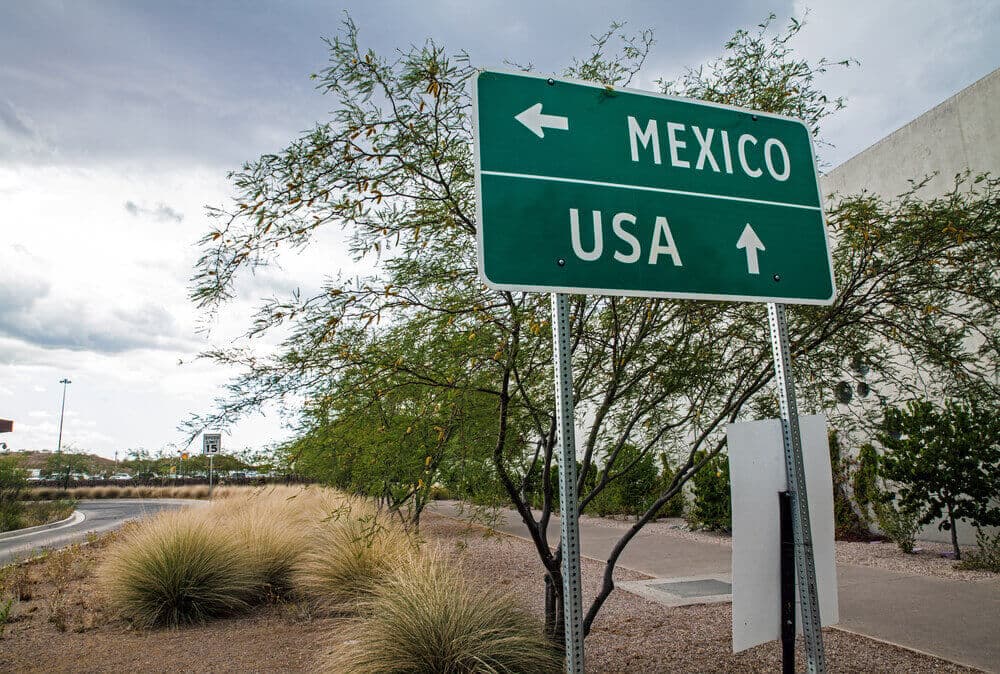Meth in the South: America’s Most Dangerous Drug
Methamphetamines have a long and tragic history in the southern United States. In many states along the Mexican border, meth has been the most widely spread and frequently misused controlled substance, with drug cartels targeting the porous border, rural communities, and vast spaces that make up the South. Meth in the South has changed the way of life for residents there and presented law enforcement with an ever-evolving problem.
This page will discuss the meth epidemic in the US, what actions have been taken against it, and what more can be done to combat meth use across the country.

America’s Most Dangerous Drug
Methamphetamine trafficking and misuse are not recent concerns. Newsweek referred to meth as “America’s Most Dangerous Drug” in 2005. In 2017, NBC News reported that mass production of meth in Mexico, combined with “an increase in potency and affordability,” has empowered cartels to get a stronger foothold north of the border, which they do by reaching deep into the American South.
While the country debates how to turn the tide against the spread of heroin and prescription painkillers, meth has made a silent resurgence. A drug misuse researcher at the University of Texas at Austin noted that as a result of a spike in meth use, the Lone Star State has seen a rise in:
- Fatalities.
- Admissions to treatment centers.
- Calls to poison control.
Henry Brownstein, the author of The Methamphetamine Industry in America, wrote in his book that when meth first made its arrival in the early 2000s, it was produced and distributed by small-time dealers.
Where Is Meth Most Popular?
According to data from the 2018 and 2019 National Surveys on Drug Use and Health (NSDUH), the following had the highest prevalence of meth use by state in the previous year:
- Arizona: 1.90% of residents 18 and older
- Montana: 1.53% of residents 18 and older
- West Virginia: 1.46% of residents 18 and older
- Hawaii: 1.42% of residents 18 and older
- Kansas: 1.39% of residents 18 and older
The Combat Methamphetamine Epidemic Act
Then came the Combat Methamphetamine Epidemic Act of 2005 (CMEA), which imposed strict regulations on the over-the-counter cold medicines that were used in the production of meth.
Ephedrine, pseudoephedrine, and phenylpropanolamine are precursor chemicals (chemical compounds that participate in a chemical reaction to create another compound) that are normally found in simple medicines to treat colds, coughs, and allergies, such as Sudafed.
However, the same chemicals are also used in the illegal production of methamphetamine. The CMEA bill was passed with the hope that home-cooked meth would be rendered harder to make. It did this by requiring pharmacies to:
- Put pseudoephedrine behind the counter.
- Not sell more than 7.5 grams of the substance to customers in a single 30-day period.
- Track sales.
The initial effects were positive; meth labs either folded or were raided by police, and the tide turned so precipitously that the number of federal prosecutions of meth offenses and the amount of meth itself that was seized by police went down. Federal data confirmed that the number of people seeking help for meth use declined, and it seemed like America had won the war against methamphetamine.
However, the early success created a void that was filled by “entrepreneurial traffickers” in Mexico. A retired Air Force captain who moved to specializing in the Mexican drug war told the Washington Post that as early as 2002, the Sinaloa cartel identified meth as “the next big thing” and took the lead in creating meth in super labs in territories they control.
Even though the Food & Drug Administration came down on the precursor materials to make meth, Mexico’s weaker justice system allowed for those chemicals to be easily obtained by the cartels. The Mexican government has restrictions, but there is such rampant corruption among law enforcement that there was nothing to stop the cartels from moving into the vacant American methamphetamine market.

Pure Meth Entering the U.S. from Mexico
So much meth flooded the southern states that the price of the product plunged in 2007 and has continued to remain affordable to consumers and lucrative to the drug lords. The Drug Enforcement Administration reported that “the purity of meth consumed in the United States rose to nearly 100 percent.”
Most of the meth from Mexico enters the US over the Southern California border, where, as The New York Times explains, people can simply carry the product with them as the pass through customs checkpoints. Larger shipments are made by cars or trucks with special compartments to conceal the product. Since meth can be converted to liquid, it has been smuggled in through iced tea bottles, disguised as shampoo for horses, and even hidden in tortillas.
Customs & Border Protection have focused their efforts on the Mexico-California border and San Diego International Airport. In 2018, U.S. Customs and Border Protection along the southwest border seized 39,268 kilograms of meth; just 1 year later in 2019, they confiscated 68,355 kilograms. Recently, in Southern California, 2,200 pounds of methamphetamine was seized at the U.S. border—one of the largest seizures of meth in the region.
The Mexican drug rings have been so successful in dispatching massive shipments of meth into the border towns and cities of the South that they have effectively pushed the Colombian cocaine cartels out of business, and even the illegal marijuana trade has taken a hit.
The Methamphetamine Surplus
Capitalizing on the decline of American-made meth and the rampant demand for it in rural border towns, the cartels produce large enough quantities of the drug that their overhead costs have become negligible. A DEA agent based in San Diego told Vice that “about 90% of meth” originates in Mexico, with a chemical purity (and potency) that had never been seen when America’s meth problem was homegrown.
The unexpected downside of the end of that homegrown problem was that it opened up rural and suburban areas of the southern United States to the cartels, which not only feeds the addictions of the people living in those areas but has also led to a rise in meth-related health concerns and crimes in areas that lie along the traffickers’ routes.
The San Diego Association of Governments released a report that found that meth use among adult male arrestees was at a 22-year high in the region. While 28% of adult male arrestees used meth in 2000, in 2021, that percentage was at 58%.
The bustling cities of Los Angeles and San Diego are popular destinations because the dense network of highways allows carriers to quickly spread their products far across the region; however, the remote and poorly policed countryside remains the most attractive to traffickers. One unexpected reason for this is that the Mexican super labs are producing so much meth that smugglers want to offload as much of the product as they can before police catch on.
An addiction psychiatrist and executive director of an LA-based treatment center told Vice that Los Angeles serves as a hub for traffickers, who like to use the urban advantages of the city but prefer doing business in rural Southern California, where there is less scrutiny and law enforcement is sparse.
The explosion of Mexican-made meth in Southern California has been echoed across other states below the Mason-Dixon line. FOX News writes of how Georgia has claimed the unwanted record of having the biggest meth bust on American soil after five men were arrested in fall 2017 for trafficking 30 kilos of the drug, which had a street value of more than $3 million.
The Georgia Bureau of Investigations said that in the past, meth operations were confined to the metro Atlanta area; for busts of such size to happen in smaller jurisdictions and smaller communities, “this is very unusual.” It was the fifth police operation that broke up a meth ring worth more than $1 million since the beginning of 2017. Investigators believe that the drugs came from Mexico.
Traffickers use Interstate 20 to connect to major hubs like Dallas and Atlanta, then disperse their meth in smaller areas across the South.
Meth Epidemic in South Carolina
In February 2018, local news in South Carolina reported on a routine traffic stop turning into an arrest for the driver carrying 5.3 pounds of methamphetamine “about 400 feet away from I-85,” which serves as a conduit for traffickers to get to the upstate region of the state.
A DEA agent said that after the drugs make it across the Mexican border, the road networks make it easy for the meth to get around. Sheriffs for four counties in South Carolina said that meth is behind most of the crimes committed in their jurisdictions, such as property crime, requiring police to allocate extra resources and time to keep up with the flow and the effects.
DEA investigations into the meth trade in the South have discovered that Atlanta acts as a hub for the entire southeastern United States, being targeted by at least five drug cartels. Interstate 85 makes the drive between the two areas less than three hours long; an alternate route is through Columbia and Charleston, which is also home to “significant drug cartel activity.”
A drug threat assessment compiled by the DEA identified the Jalisco New Generation cartel as the primary cartel conducting drug trafficking in those two cities, although the cartels have a presence in almost all major cities to the point where the DEA warns that “meth is a major threat in South Carolina right now.”
Charleston’s Post and Courier wrote of how even though Mexican meth knocked the American product out of the market, the ease with which the drug can be made—with nothing more than a soda bottle and ingredients purchased at a hardware store—has resulted in a mini-surge in the return of homemade meth in South Carolina. Local addicts and dealers are cooking up the drug in “cars, parks, motel rooms [and] boats.”
A narcotics unit supervisor with Berkeley County compared the rise of meth and the return of local production to a plague. The Post and Courier noted of how both North and South Carolina have experienced hundreds of meth lab seizures in just a few years, and the state of Georgia almost ran out of money for cleaning up meth labs.
Even when authorities make arrests and busts, the mood is pessimistic. Addiction is so prevalent in places like Pickens County, where dozens of people were arrested, that public health experts have had to come up with new treatment methods to serve the several hundreds of people who need help.
For as successful as domestic efforts were in cutting down on the operations of local meth labs, the effect from across the southern border has been devastating. The officer leading the drug investigations in the Pickens County Sheriff’s Office said that the supply of Mexican meth is so strong that dealers who used to sell by the gram now sell in ounces and pounds.

Socioeconomic Conditions
Many residents fell back on using and dealing meth to cope with being “chained to a life of poverty.” People in the area told the filmmakers that with so much meth coming from Mexico, there was no longer any need to cook the product themselves. One person told the crew that 90 percent of the residents living in the area were addicted to methamphetamines.
But despite the strong presence of the drug from Mexico, many people are compelled to try and get in on the business themselves. The documentary filmmakers also worked with Johnny Sowell, an Arkansas DEA agent who was part of Operation ICE STORM, a series of raids that netted a number of arrests and large-scale seizures of meth and weapons in Clinton, in Van Buren County.
According to Sowell, the depressed central Arkansas region is a target for the cartels to move their meth to. The DEA went from busting “backyard labs” of residents making small amounts of the drug to intercepting up to 40 pounds being shipped in every week.
In Clinton, with a population of just 2,518 people, opportunities are scarce; residents turned to what seemed to be the most lucrative and attractive proposition, which was getting into the meth business. The cartels are more than happy to keep that going. Sowell told the HBO crew that even if the DEA arrests 50 dealers, “the cartels send 50 more to take their place.”
Meth as a Way of Life
In some parts of Texas, especially Nacogdoches County, meth is almost a way of life. Kent Graham, a narcotics investigator, told Texas Monthly that the family tradition in the backwater regions of the state is no longer making moonshine. Now, he says, it is meth, with entire families getting in on the act. With not much by way of education or job opportunities in Nacogdoches (230 miles away from Austin), the ubiquity of meth and its affordability make it a very popular commodity.
A single dose (a quarter of a gram) costs just $25 and provides a high that lasts for 12 hours. Users not only get the euphoric blast, they feel powerful, confident, and almost superhuman. In a place where traditional and longstanding industries, such as the logging and paper mill businesses, have had to close their doors, such self-assuredness is like ambrosia.
In some areas of rural Texas, writes Texas Monthly, most people know someone know who has an addiction to meth; more often than not, that person is a member of their family. The treatment facilities are backed up, and the courts are overwhelmed by people who have been charged with meth manufacturing or distribution.
The jails cannot hold any more inmates. The Child Protective Services supervisor in Angelina County said that when investigating a call about abusive parents, the first question her department asks is if the parents are on meth. Seven or eight years ago, that was barely a concern; now, she says, “it’s responsible for a third of our caseload.”
Meth Use in Rural Texas
In family court in Angelina County, the court-at-law judge said that most of the divorce cases that come in front of her involve meth use. In a single child-custody case, both parents and three out of four grandparents tested positive for meth consumption; the only grandparent who was clean was a grandmother who was on probation for making meth.
The culture of methamphetamine use has become so ingrained, that addictions spread across entire families and homes. The Texas Monthly article noted that teenagers are introduced to meth by aunts, uncles, and even parents. Law enforcement fear that an entire generation of children is growing up literally watching their parents cook meth and being exposed to the realities of drug use and trafficking—violence, abuse and neglect, sexual exploitation, and a feeling that the cycle is unbreakable.
Kent Graham, the narcotics investigator for Nacogdoches County, told Texas Monthly that most of the people he arrests plead guilty to lesser charges in order to receive as little prison time as possible. Every time a cook is put behind bars, another one emerges. Graham has arrested hundreds of people as part of rural Texas’s meth problem, but only 15 of them have committed to seeking treatment and only one has stayed sober. Graham’s only comfort is that things could be worse.

Can Regulation Help?
The Consumer Healthcare Products Association, which runs a campaign called “Stop Meth, Not Meds,” argues that limiting access to pseudoephedrine-based products unfairly targets low-income families who would not be able to afford the prescriptions for Sudafed and Mucinex.
There are some points of hope for the future. States that have regulated that pseudoephedrine be made prescription-only have experienced “dramatic reductions” in the number of homegrown meth labs. Mississippi, for example, saw a 70% drop in the number of seizures the year after the state legislature put pseudoephedrine behind the counter (2010).
Similarly, the number of children placed in foster care due to meth-related use issues went down by 81%. The methamphetamine program coordinator with the Mississippi Bureau of Narcotics told the Post and Courier that his state cracked down on 692 meth labs in 2009; in 2013, three years after the pseudoephedrine regulation, only four active labs were discovered.
While Mississippi is now the only state to require a prescription for pseudoephedrine, cold and allergy medicines that use the chemical are available without a prescription in places like South Carolina. There, all that is needed to get such medication is a picture ID and signing for the purchase in an electronic or paper log.
The Consumer Healthcare Products Association has clashed with South Carolina representatives on the effectiveness of tighter regulations on medications that use pseudoephedrine. While the two are locked in stalemate, law enforcement and public health officials across the South are left with little option but to fight the meth epidemic every day.
Meth Addiction Treatment
If you or someone you love are struggling with methamphetamine addiction, help is available. Oxford Treatment Center—an outpatient and inpatient drug and alcohol rehab in Mississippi—offers several levels of addiction treatment. Premier clinicians employ evidence-based therapies and customized care.
Find out more by calling a compassionate admissions navigator at . They are available 24/7 to answer your questions about substance use treatment, the treatment admissions process, and rehab payment options.
You can quickly check your drug and alcohol rehab coverage using our confidential . Don’t wait another day to reach out for the help you deserve.